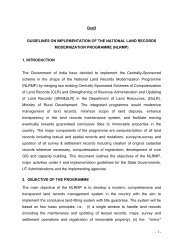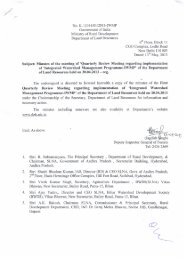Uttarakhand - Department of Land Resources
Uttarakhand - Department of Land Resources
Uttarakhand - Department of Land Resources
You also want an ePaper? Increase the reach of your titles
YUMPU automatically turns print PDFs into web optimized ePapers that Google loves.
CHAPTER - 5<br />
ISSUES AND CHALLENGES<br />
The state <strong>of</strong> <strong>Uttarakhand</strong> is a region <strong>of</strong> outstanding natural beauty with tremendous<br />
potential for sustainable growth and development. The northern region <strong>of</strong> the State is<br />
part <strong>of</strong> the Great Himalayan Range, covered in snow and glaciers. Other parts <strong>of</strong><br />
<strong>Uttarakhand</strong> are covered in dense forest making up the bulk <strong>of</strong> its natural resources<br />
base. The largely mountainous nature <strong>of</strong> the state endows it with a unique<br />
ecosystem that is home to a large number <strong>of</strong> flora and fauna. Two <strong>of</strong> the Indian<br />
subcontinents most important rivers - the Ganga and Yamuna also originate from the<br />
glaciers <strong>of</strong> <strong>Uttarakhand</strong>.<br />
After attaining statehood in 2000, the economic progress <strong>of</strong> <strong>Uttarakhand</strong> has been<br />
rapid, with its economic growth rate increasing from just over 3% per annum to 11%<br />
per annum. However, this rapid growth has been accompanied by adverse impacts<br />
on the local ecology, thus making the incorporation <strong>of</strong> sustainable development<br />
practices into the State‟s overall development strategy an imperative.<br />
Water, agriculture, forestry and energy, among other issues, are central to the<br />
State‟s inclusive strategy for future growth. Most <strong>of</strong> the people <strong>of</strong> this state are<br />
dependent on their natural environment, with over three-fourths <strong>of</strong> the total<br />
population dependent on agriculture for their livelihood. Also, with over fifteen<br />
important rivers and over a dozen glaciers in the State, <strong>Uttarakhand</strong> is a valuable<br />
fresh water reserve. There are also about 200 large and medium sized hydroprojects<br />
and therefore hydroelectricity continues to be a prime source <strong>of</strong> capital for<br />
the local economy. Forests cover a large percentage <strong>of</strong> the land area with many<br />
industries being forest based.<br />
CHALLENGES FOR FOOD SECURITY<br />
Subsistence agriculture is the prime source <strong>of</strong> livelihood and employment <strong>of</strong> more<br />
than seventy percent <strong>of</strong> the population in <strong>Uttarakhand</strong>. It accounts for about thirtyseven<br />
percent <strong>of</strong> the Net Domestic Product <strong>of</strong> the state. Agriculture in <strong>Uttarakhand</strong> is<br />
very complex and is interlinked with crop husbandry, animal husbandry and forestry<br />
99
















